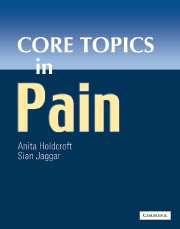Book contents
- Frontmatter
- Contents
- Contributors
- Preface
- Acknowledgements
- Foreword
- General abbreviations
- Basic science abbreviations
- PART 1 BASIC SCIENCE
- PART 2 PAIN ASSESSMENT
- Section 2a Pain measurement
- Section 2b Diagnostic strategies
- PART 3 PAIN IN THE CLINICAL SETTING
- Section 3a Clinical presentations
- 14 Epidemiology of pain
- 15 Pain progression
- 16 Analgesia in the intensive care unit
- 17 The chronic pain patient
- 18 Post-operative pain management in day case surgery
- Section 3b Pain syndromes
- PART 4 THE ROLE OF EVIDENCE IN PAIN MANAGEMENT
- PART 5 TREATMENT OF PAIN
- Section 5a General Principles
- Section 5b Physical treatments
- Section 5c Pharmacology
- Section 5d Psychosocial
- PART 6 SUMMARIES
- Glossary
- Index
18 - Post-operative pain management in day case surgery
from Section 3a - Clinical presentations
Published online by Cambridge University Press: 10 December 2009
- Frontmatter
- Contents
- Contributors
- Preface
- Acknowledgements
- Foreword
- General abbreviations
- Basic science abbreviations
- PART 1 BASIC SCIENCE
- PART 2 PAIN ASSESSMENT
- Section 2a Pain measurement
- Section 2b Diagnostic strategies
- PART 3 PAIN IN THE CLINICAL SETTING
- Section 3a Clinical presentations
- 14 Epidemiology of pain
- 15 Pain progression
- 16 Analgesia in the intensive care unit
- 17 The chronic pain patient
- 18 Post-operative pain management in day case surgery
- Section 3b Pain syndromes
- PART 4 THE ROLE OF EVIDENCE IN PAIN MANAGEMENT
- PART 5 TREATMENT OF PAIN
- Section 5a General Principles
- Section 5b Physical treatments
- Section 5c Pharmacology
- Section 5d Psychosocial
- PART 6 SUMMARIES
- Glossary
- Index
Summary
Introduction
Day case surgery (DCS) forms an increasingly large part of all surgery performed in the developed world. In fact, it was an American anaesthesiologist who opened the first ‘Downtown Anaesthesia Clinic’ in Iowa in the early 1900s. Today about 60% of all surgery in the US is performed in day case units and about 50% of surgery in UK is ambulatory. In this context, the UK Department of Health (2002) has recently published a ‘Basket of 25’ of the most important procedures to be performed as DCS.
Advantages of DCS
Better patient satisfaction: Patients may choose their admission date, leading to greater satisfaction and a substantial decrease in appointment cancellations. Furthermore, patients subsequently go home; in fact, to much more agreeable and convenient surroundings for their recovery.
Greater cost effectiveness: Procedures in DCS can be performed in a much more cost- and time-effective fashion, thus increasing the numbers of patients that can be treated, resulting in shorter waiting lists.
Disadvantages of and differences between DCS and inpatient surgery
Quality standards must be set higher for DCS than inpatient surgery because complications have a greater overall impact and the opportunity and time for correcting problems is much more limited.
DCS has a narrower range of analgesic drugs/regimens/techniques available because of higher security and quality standards.
[…]
- Type
- Chapter
- Information
- Core Topics in Pain , pp. 121 - 126Publisher: Cambridge University PressPrint publication year: 2005



